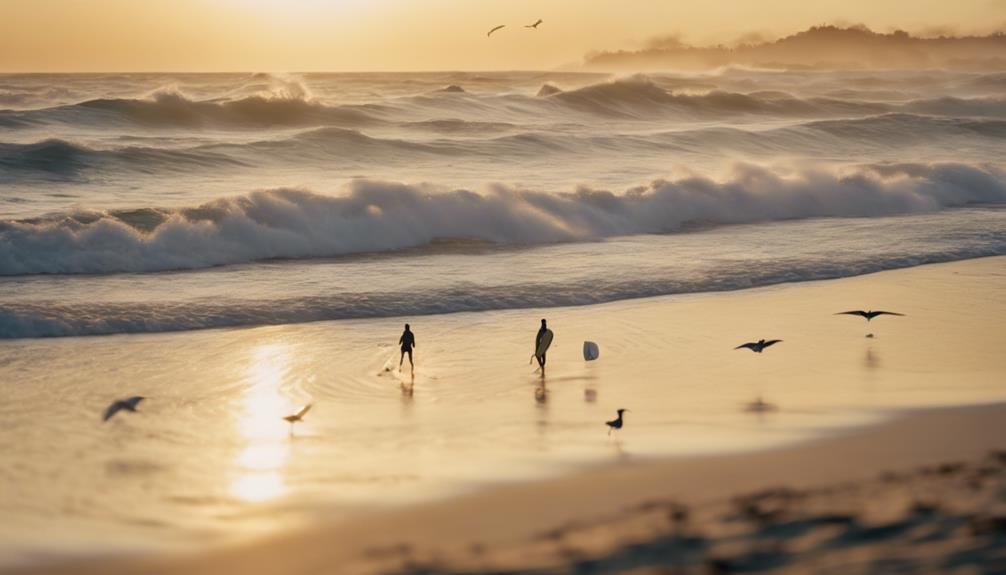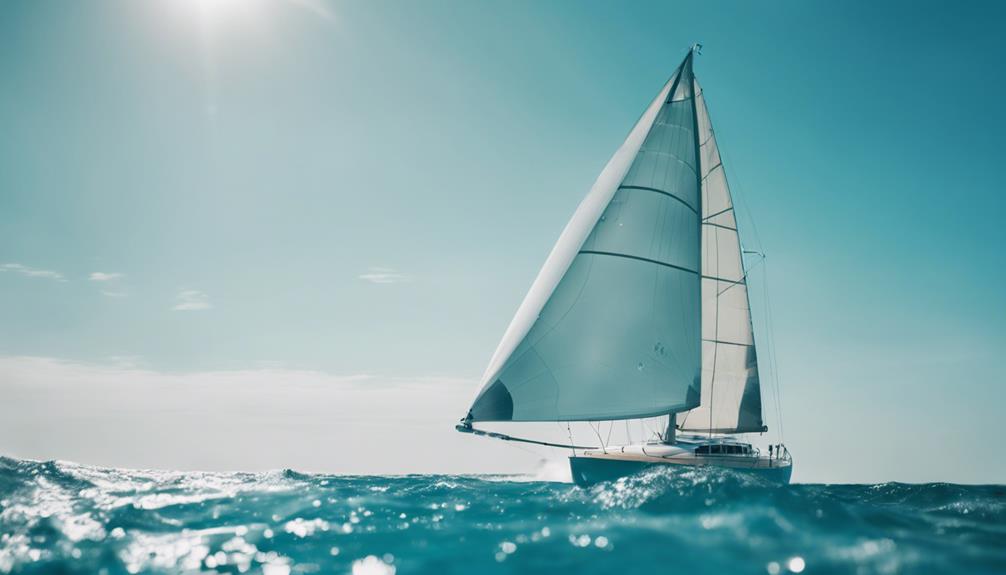Sails and sailboats are closely related but serve different purposes. A sail is the fabric structure that captures wind, generating propulsion for sailing. It comes in various types, like mainsails and headsails, each optimized for performance. On the other hand, a sailboat is the complete vessel that uses sails for movement across water, featuring components like the hull, mast, and rigging. While sails focus on capturing wind, sailboats combine those sails with design and structure for an effective sailing experience. If you want to understand more about their unique functions and components, keep exploring!
Key Takeaways
- Sails are fabric structures that capture wind, while sailboats are watercraft primarily powered by sails for movement.
- Key components of sails include luff, leech, foot, and clew, which influence performance and shape.
- Sailboats consist of a hull, mast, rigging, and sails, all contributing to navigation and speed.
- Different types of sailboats, like sloops and multi-hulls, cater to various sailing preferences and conditions.
Definition of Sails
Sails are essential fabric structures that capture wind to propel a sailboat forward. They play a vital role in sailing, transforming wind energy into movement. The primary types of sails include mainsails, headsails (like jibs and genoas), spinnakers, and storm sails, each designed for specific wind conditions and sailing purposes.
Understanding sails' anatomy is key to effectively using them. Parts like the luff (front edge), leech (back edge), foot (bottom edge), tack (corner at the base), and clew (corner where leech and foot meet) all contribute to how well a sail performs. The shape of the sail is critical, as adjustments to camber and angle of attack can optimize wind capture and sailing efficiency based on conditions.
Materials used for sails also vary widely. For cruising, you might find Dacron, known for its durability, while racing sails often incorporate lightweight laminates for better performance.
Knowing these details about sails helps you appreciate their significance in sailing and sailing performance, ensuring you can make informed choices when you're out on the water.
Definition of Sailboats

A sailboat is a watercraft primarily powered by sails, harnessing the wind to move across water.
You'll find different components like the mast, boom, and various sails working together, as well as various types ranging from monohulls to multihulls.
Each design affects how the boat handles and performs, making the choice of sailboat essential for your sailing experience.
Components of Sailboats
Sailboats combine various components, including the hull, mast, and rigging, to harness wind energy for propulsion. Understanding these parts helps you appreciate how sails are made and how they function together.
Here are the key components of a sailboat:
- Hull: The body of the boat that floats on water, providing buoyancy and structure.
- Mast: The vertical pole that supports the sails, essential for their positioning and angle relative to the wind.
- Rigging: The system of ropes and cables used to control the sails, allowing you to adjust them for ideal performance.
- Keel: A critical part that provides stability and prevents sideways drift, helping maintain directional control.
Sailboats are equipped with different sails, like mainsails and headsails (jibs or genoas), which work together to maximize speed and efficiency based on wind conditions.
Types of Sailboats
Exploring the various types of sailboats reveals a diverse range of designs tailored for different sailing experiences and conditions. Sailboats are primarily categorized by their rigging configurations, such as the popular sloop rig, which uses a single mast with two sails: the mainsail and headsail.
You'll find multi-hull sailboats, like catamarans and trimarans, offering improved stability and space compared to traditional mono-hulls. Performance sailboats focus on speed, utilizing specialized hull shapes and lightweight materials, making them ideal for racing. In contrast, cruising sailboats prioritize comfort and storage, featuring amenities for extended voyages.
Here's a breakdown of the main types of sailboats:
| Type | Key Features | Best Conditions |
|---|---|---|
| Sloop | Single mast, mainsail, headsail | Versatile for most winds |
| Multi-hull | Stability, space | Calm to moderate winds |
| Performance | Lightweight, optimized for speed | Racing and competitive |
Each type suits different sailing conditions, influencing the design and choice of different sails. By understanding these categories, you can choose the right sailboat for your adventures.
Key Components of Sails

Understanding the key components of sails is essential for mastering their performance and optimizing your sailing experience. A well-designed sail can greatly enhance your ability to capture wind and navigate effectively.
Here are four vital components you should know:
- Luff: This is the front edge of the sail, vital for maintaining sail shape and directing airflow.
- Leech: The back edge of the sail, where you often adjust tension to optimize performance and manage the flow of wind.
- Foot: The bottom edge of the sail, which helps determine the sail's overall shape and height, impacting how efficiently it catches the wind.
- Clew: The corner where the leech and foot meet, acting as a key point for adjusting sail shape and tension to suit varying wind conditions.
Mainsails, the largest sails on a sailboat, are found behind the mast and provide primary propulsion. In contrast, headsails, like jibs and genoas, are positioned forward and assist with steering and balance.
Understanding these components will help you adjust your sails effectively for various sailing conditions.
Key Components of Sailboats

The key components of a sailboat work together harmoniously to guarantee stability, control, and propulsion on the water.
First, the hull provides buoyancy and stability, ensuring your sailboat floats and remains balanced.
Next, there's the rigging, which supports the sails and allows you to control their shape and orientation for ideal performance.
The mainsail, the largest sail positioned behind the mast, serves as your primary source of propulsion, driving your sailboat forward.
Meanwhile, headsails like jibs and genoas, located at the front of the mast, help with balance and steering by capturing additional wind, enhancing your ability to maneuver.
Another crucial element is the keel, which provides lateral resistance against sideways movement. This component helps maintain directional control and generates lift through the flow of water, keeping you on course.
Finally, the rudder, usually mounted at the stern, is essential for steering. By changing the rudder's position, you navigate your sailboat relative to the wind, allowing for smooth and effective travel on the water.
Understanding these key components of sailboats will enhance your sailing experience and make your time on the water more enjoyable.
Functions of Sails

Sails play an essential role in propelling your sailboat forward by harnessing wind energy to create lift, much like an airplane wing. Understanding the functions of sails is vital for maximizing your sailing experience.
Here are the key functions they provide:
- Primary Propulsion: The mainsail is your sailboat's largest sail, acting as the main driving force for propulsion and balance.
- Enhancing Speed: Headsails, such as jibs and genoas, are smaller sails that capture additional wind, improving both speed and steering capabilities.
- Downwind Performance: Spinnakers are specialized sails designed for downwind sailing, maximizing their surface area to catch wind and greatly increase speed in those conditions.
- Adjustable Design: The shape and design of sails can be modified for best performance. Flatter sails are great for racing, while deeper sails offer more power in lighter winds.
Functions of Sailboats

Harnessing wind power, sailboats efficiently glide across water, combining sail design with hull structure to improve performance and maneuverability. The primary functions of sailboats revolve around utilizing sails to create lift, propelling the vessel forward while minimizing drag. Their hulls are specifically shaped to guarantee stability, allowing you to navigate different water conditions with ease.
One key function of sailboats is the keel, which provides essential lateral resistance. This design feature prevents sideways slipping, enabling you to maintain better control over your direction. The combination of sails and hull design allows sailboats to achieve peak speed, especially when sailing at angles to the wind.
Moreover, various types of sails, like mainsails and headsails, serve specific functions that enhance the boat's maneuverability and speed across diverse sailing conditions. Each sail contributes to the overall efficiency of the vessel, ensuring you can tackle various wind strengths and directions effectively.
Sailing Techniques and Maneuvers

When you're out on the water, mastering tacking and gybing techniques is vital for effective navigation.
You'll also need to adjust sail trim for ideal performance and understand navigational maneuvering strategies to stay on course.
Let's explore these essential sailing skills that will enhance your experience on a sailboat.
Tacking and Gybing Techniques
How do tacking and gybing enhance your sailing experience and performance? Mastering these techniques is essential for steering efficiently and maximizing your speed on the water.
Here are four key benefits of tacking and gybing:
- Improved Upwind Performance: Tacking allows you to turn the bow through the wind, letting your sails fill from the opposite side and helping you sail upwind effectively.
- Increased Control: During a tack, you can anticipate wind shifts and adjust the sails to maintain speed and direction, ensuring a smoother ride.
- Enhanced Maneuverability: Gybing, while more challenging, enables you to change your course by turning the stern through the wind, allowing for greater flexibility in your sailing route.
- Team Coordination: Both maneuvers require precise teamwork, with the skipper directing and crew members managing sheets and lines, fostering a sense of camaraderie on board.
Sail Trim Adjustments
Sail trim adjustments play an important role in optimizing your boat's performance by fine-tuning the sails to capture wind effectively. When you alter the angle and shape of your sails, you enhance both speed and stability while sailing. A properly trimmed mainsail guarantees efficient airflow along the leech, reducing drag and improving your overall performance, especially during tacking and gybing maneuvers.
To achieve the ideal sail profiles for varying wind conditions, you can modify the tension on the sail's luff and adjust the shape of the foot using systems like halyards and outhauls. In light winds, trim your sails to a fuller shape to maximize lift. Conversely, in strong winds, flatten your sails to reduce power and maintain control.
It's vital to continuously monitor the apparent wind direction and speed, as these factors directly influence your boat's performance and handling. By making timely sail trim adjustments, you'll guarantee your boat sails efficiently and responds well to changing conditions, enhancing your overall sailing experience.
Navigational Maneuvering Strategies
Mastering sail trim adjustments sets the stage for effective navigational maneuvering strategies, enabling you to handle your sailboat skillfully in various wind conditions.
To enhance your sailboat speed and maneuverability, focus on these key techniques:
- Tacking: This maneuver helps you change direction by turning the bow into the wind, filling the sails on the opposite side. It's essential for sailing upwind.
- Gybing: When sailing downwind, turn the stern through the wind to shift the sails from one side to the other. Be careful to avoid accidental jibes, which can disrupt speed.
- Point of Sail: Recognize how different points of sail affect your boat's interaction with the wind. Adjust your sails accordingly for peak performance while beating or running.
- Wind Shadows: Understand how your sails and hull create wind shadows that can affect airflow. Adjust to maintain lift and speed during maneuvers.
Maintenance and Care Requirements

Regular maintenance is essential for both sails and sailboats to guarantee their performance and longevity on the water.
When it comes to sails, you'll want to inspect them regularly for any signs of wear and tear. Check all seams, stitching, and hardware to verify they're intact.
After sailing in saltwater, clean your sails with fresh water and let them dry completely to prevent mold and mildew. Proper storage is also important; keep your sails in a cool, dry place to avoid UV damage and environmental deterioration.
For sailboats, routine maintenance involves inspecting the rigging. Look for frayed lines and adjust the tension as needed to secure optimal performance and safety.
Additionally, regularly inspect and service the hull and keel of your boat. This helps prevent water intrusion and maintains the vessel's structural integrity, which is essential for overall sailing efficiency.
Different Types of Sailing Experiences

Exploring the various types of sailing experiences can help you find the perfect match for your interests and skill level. Each type offers unique benefits, so consider what excites you most.
Here are four different types of sailing experiences:
- Cruising: Enjoy leisurely sailing on comfortable vessels designed for long-distance travel. This experience focuses on exploration and relaxation.
- Racing: If you're after adrenaline, racing might be your game. It emphasizes speed and competition, using specialized boats crafted for performance.
- Day Sailing: Perfect for a quick getaway, day sailing involves short trips lasting just a few hours. You'll use smaller boats, making it easy to enjoy sailing without the need for overnight planning.
- Charter Sailing: Rent a boat for a specific time and experience sailing without the responsibilities of ownership. Many charters come with a skipper or crew to guide you.
Frequently Asked Questions
What Is the Difference Between a Sailboat and a Sailing Boat?
A sailboat's a broad term for vessels powered by sails, while a sailing boat usually refers to smaller, more manageable options for leisure. You'll find sailing boats easier for beginners to handle and enjoy.
What Makes a Sailboat Sail?
Imagine harnessing the wind's power like a wizard! A sailboat sails by capturing wind through its sails, generating lift and thrust, while its keel keeps you on course, gliding smoothly across the water's surface.
What Is the Difference Between the Jib and the Mainsail?
The jib's a smaller sail at the front, aiding in speed and steering, while the mainsail, larger and behind the mast, generates most of the thrust, essential for effective sailing maneuvers.
What Are the 3 Points of a Sail?
The three key points of a sail are the tack, clew, and luff. Each plays an essential role in sail shape and performance, so understanding their positions helps you optimize your sailing experience effectively.
What are the Key Differences Between a Sail and a Sailboat?
When considering a sail boat vs sailing boat, the key difference lies in the terminology. A sail refers to the piece of fabric designed to catch the wind and propel a boat, while a sailboat refers to the entire watercraft that is powered by a sail. Understanding this distinction is important for anyone interested in maritime activities.
Conclusion
In the world of sailing, understanding the difference between sails and sailboats is like distinguishing between the wind and the waves—both essential, yet uniquely powerful.
Whether you're harnessing the wind with a crisp, white sail or cruising the open waters in a sleek sailboat, each experience offers a thrill like no other.
So, as you begin your sailing journey, embrace the harmony of both and let the adventure guide you to new horizons!










